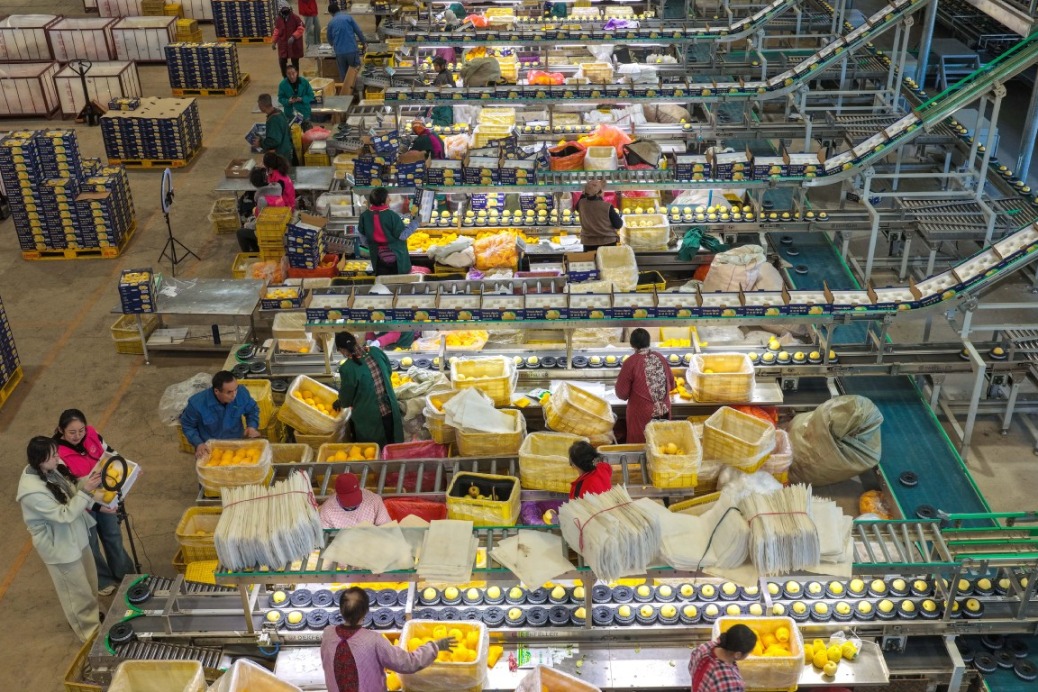Feed grain changes needed


It is grain for livestock not for human consumption that will influence global food security
To ensure food security, China has established a series of policies including absolute self-sufficiency in crop production, a bottom-line for permanent farmland protection, an occupation and compensation balance for arable land, construction of high-standard farmland, and farmer subsidies that improve the capacity of grain production, thanks to which the peak yield of grain production reached 669.5 million metric tons in 2020-about one-fourth of the aggregate global food production, according to data from the National Bureau of Statistics.
China has not only fed 20 percent of the world's population using just 9 percent of the world's arable land and 6 percent of the world's freshwater resources, but has also made valuable contributions to the eradication of poverty and the realizing of the Sustainable Development Goals set by the United Nations.
China imported 143 million tons of grain in 2020, more than doubling the amount in 2010, accounting for 31.37 percent, nearly one-third, of the global grain trade, up from 19.82 percent in 2010, according to statistics from the General Administration of Customs of China.
However, the growth of grain production in China and on the planet has been stagnant. China's grain production registered an average annual increase rate of only 0.27 percent from 2010 to 2020, even witnessing a 0.78 percent decline from 2019 to 2020, according to the Food and Agriculture Organization of the UN. The stagnation of grain production and the skyrocketing amount of grain imported by China has posed great challenges to the food security of not just China, but the world. The world population in 2020 was 7.79 billion and is expected to reach 8.73 billion by 2030. It will be a tremendous challenge to meet the food needs of an additional nearly 1 billion people.
China's huge amount of grain imports can be explained by analyzing the changes in China's grain import structure. In 2020, the imports of soybean and corn, which, as the major feed grain, are mainly used to meet the needs of meat production, increased rapidly. The continuous growth in China's imports of soybean and corn can be explained by the increasing demand for feed consumption. There is a concerning production gap for soybean in China.
China's consumption of soybean in 2020 was 117.7 million tons, 99 million tons of which, or 84.11 percent, was for feed grain consumption. Although China's annual soybean output has been increasing since 2015, the yield in 2020 was only 19.6 million tons, and the import volume was as high as 100.3 million tons, accounting for 85.2 percent of consumption. China's corn consumption in 2020 was 287 million tons, and the demand for feed consumption has shown rapid growth over the past five years, from 144 million tons in 2014 to 200 million tons in 2020, an average annual growth rate of 6.48 percent. Feed grain consumption accounted for approximately 70 percent of the total corn consumption.
A shift in the consumption pattern toward more meat has been observed in China over the past 10 years, thanks to the rapid development of China's economy, pushing up the imports of corn and soybean, even wheat and other grain, for the needs of meat production. By 2030, the imports of corn and soybean will reach 131.1 million tons and 156.8 million tons, respectively, based on China's annual import increase rate of 27.78 percent for corn and 4.56 percent for soybean over 2015 to 2020. The megatrend of China's rising grain imports poses great challenges to feeding China and the world sustainably.
Therefore, there is an urgent need for China to act to improve the self-sufficiency rate of its feed grain, and to steadily and gradually reduce its grain imports. It needs to update its food security policies and work with the rest of the world to build a community with a shared vision for food security in the post-pandemic era.
China can take various measures to achieve this goal such as lowering food demand by reducing food production losses, food waste and improving eating habits, and increasing its investment in science and technology to elevate its ability to respond to natural disasters and increase the utilization efficiency of water and soil resources to secure the stability of food production.
First, it should expand non-feed resources and replace feed grains, develop grassland resources in China to realize the exchange of grass for grain, develop new types of feed amino acid and protein resources. It is estimated that China can keep the self-sufficiency rate of its corn production at 95 percent by 2025 and that the import volume of soybean will shrink by adding investment in science and technology. By 2035, China will keep the self-sufficiency rate of its corn production above 80 percent, and imports of soybean will be about 10-20 million tons less than that in 2020.
Second, improve stock feed efficiency and resource productivity to save feed grain, enhance the utilization efficiency of stock feed and grain, and the conversion efficiency of the by-products of agricultural food.
Third, improve the production efficiency of farm animals and reduce the consumption of feed grain. China should raise grainsaving livestock and poultry breeds. In addition, it should develop accurate nutrition and promote intelligent, healthy and efficient breeding.
The author is a professor of the College of Land Science and Technology at China Agricultural University. The author contributed this article to China Watch, a think tank powered by China Daily. The views do not necessarily reflect those of China Daily.


































